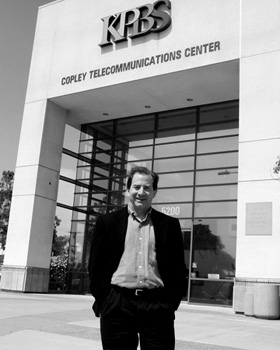| By
Donald H. Harrison
San Diego (special) Documentary maker Matthew Eisen, father of daughter
who today is 5 years old, was emotionally torn up by news reports involving
three recent cases of child abuse in San Diego.
 |
In one case, a child was scalded to death by his parents
after a social
worker with the county's Child Protective Services (CPS) visited the
home
and concluded that it was safe for him to remain there. In another,
a child
was starved to death by a father who was a religious zealot and believed
it was God's will that the child shouldn't eat. In that instance too,
a CPS
case worker previously had visited the home. In the third case, CPS
removed a raped girl from her parents' home, believing the father to
be the
rapist. Later it was discovered that the actual culprit was a sexual
offender who had been living in the neighborhood.
The terrible results in these three cases made Eisen wonder who the
people are who work |
| FILMMAKER--Matthew Eisen's documentary. |
for CPS. He wondered how CPS social workers make
their decisions in the course of thousands of cases handled by the
department. How could such awful mistakes happen? He went about
finding out during a two-year process that will culminate at 9 p.m.,
Thursday, June 21, when his hour-long documentary, "Child Protective
Services" premieres on KPBS.
There was a long, legal process before Eisen and cameraman Michael
Dean ever could shoot a piece of video. First they had to ask CPS to
let
them spend time with the case workers, follow them around, record cases
as they were happening, and also exercise complete control over the
editorial product. For references, Eisen made available to CPS his
previous documentaries on such topics as the homeless, pregnant women
who use drugs, AIDS, anti-abortionist fundamentalist churches, and
the
animal rights movement.
After finally gaining CPS's tentative consent to make the first
documentary ever about the department's workings, Eisen then had to
persuade a juvenile court judge to issue an order permitting him to
film
CPS case workers. Eventually the okay was given with the proviso that
Eisen must obtain written permission from any CPS "client" who appeared
in the video. The face of anyone who did not give written permission
must
be electronically blocked from view.
Before ever taking cameraman Dean with him, Eisen spent several weeks
in the field with CPS workers, observing them at their jobs, trying
to
understand their motivations, assessing in what editorial directions
the
documentary might lead.
He and Dean shot far more video than they could pack into an hour
documentary. Some of it, though quite emotional, simply couldn't be
shown because the "clients" withheld their permission. Showing the
CPS
side of a controversy, without showing the clients' perspective, wouldn't
have told the story in a balanced manner.
With the same determination which Eisen as an independent documentary
maker persuaded KPBS to be his co-producer, and together raise $300,000
to finance the documentary (including grants from the Rivkin and Viterbi
families), Eisen followed CPS workers as they made what literally could
be life or death decisions for the children.
The documentary footage includes, among other scenes, an actual meeting
between case workers and a family which voluntarily surrendered their
child. The father, who was suspected by CPS of abusing his son, explained
that the boy had been crying so hard, he put him in a pillow case to
restrain him, not to hurt him. Why would that father and mother want
the
story of their son's removal from their home shown on television?
According to Eisen, they felt that CPS was treating them unfairly and
wanted their side of the story shown.
In another riveting scene, CPS workers arrive at a filthy home to
determine whether the child who lives there is in any danger. The mother
is so hostile, even as a viewer you experience the high tension of
the
encounter. The woman permitted the documentary crew to use the footage,
again because she wanted people to know her side of the controversy.
But
she hedged by refusing permission for her face to be shown.
If Eisen's documentary has a point of view, it is that of the CPS workers,
not of the clients. You see how the workers wrestle with their decisions,
how they try to do what is right for the children, and how they often
experience burn out in the process.
Making such documentaries, in Eisen's view, is a way for him to help
make
the world a better place--a process that they would have called tikkun
olam at the Reform congregation where he had his bar mitzvah, Temple
Beth Israel of Champagne, Ill.
After spending two years on the project, Eisen has strong opinions and
strong emotions about the whole system of child protective services.
He
says that San Diego County residents have been shortchanged as a result
of the county paying its CPS workers approximately $10,000 a year less
than the workers in neighboring Orange and Riverside Counties.
Dedicated workers--whose judgments we can feel comfortable trusting--
are being lured away by the larger salaries, he said. Those workers
whom
San Diego County is attracting may not be capable of performing at
the
same high level, he said.
Seeing how badly children can be abused has caused Eisen to suffer what
he describes as "post-traumatic stress syndrome." While producing the
documentary, he said, he kept his emotions in check, but after it was
completed, he probably gave a scare to his wife, Karla Peterson, an
arts
writer for the San Diego Union-Tribune. Once he allowed his emotions
out,
he said, he practically would shake every time the telephone rang.
Even
though he has supervised the video many times in the editing room,
he has
not sat down to watch it as a spectator. Right now, he admitted, his
emotions are just too raw. |

